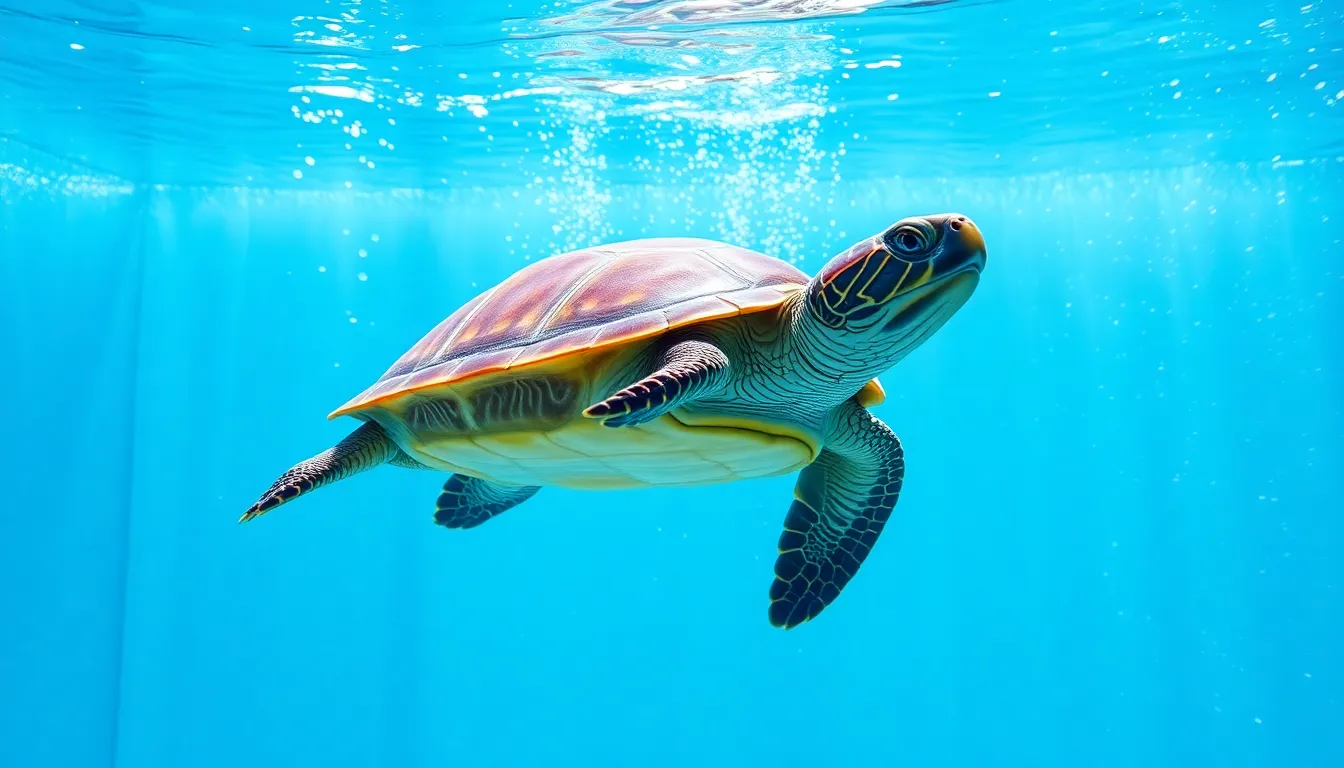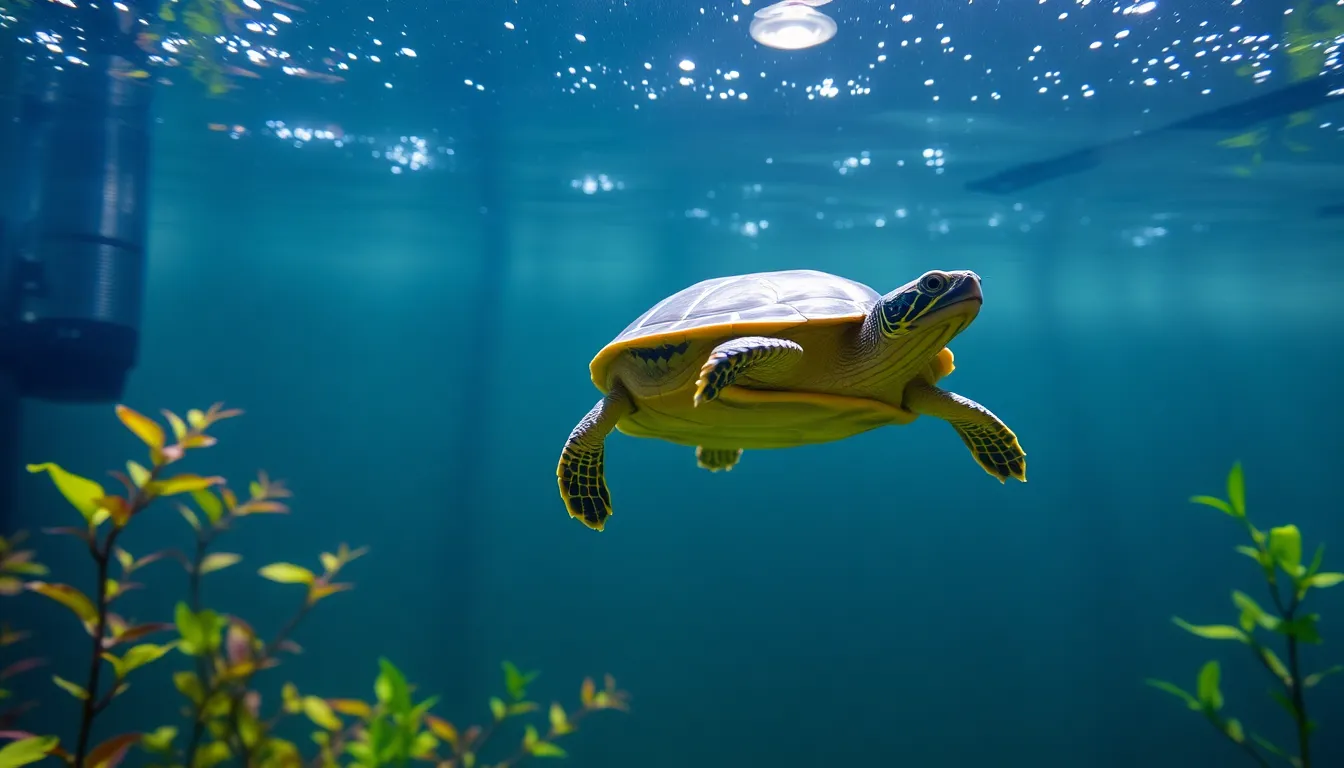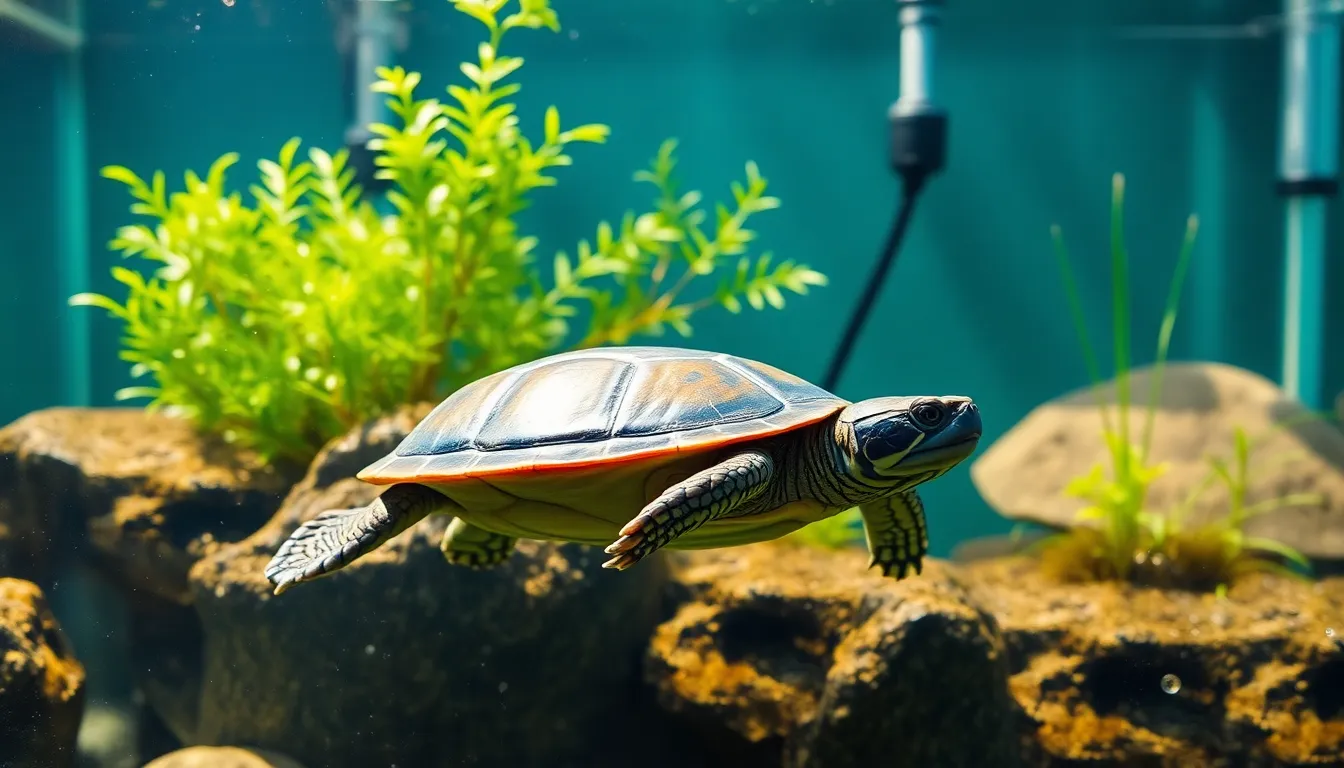Red-eared slider turtles produce substantial waste, making a robust red-eared slider turtle filter setup, particularly an over-filtered canister system, indispensable for maintaining their aquatic environment. This critical approach ensures optimal water clarity, prevents harmful toxin accumulation, and safeguards the turtle’s long-term health and well-being.
Key Implications
- Filtration System Choice: Canister filters are the primary choice for red-eared slider tanks, offering multi-stage filtration and a crucial 5-10 times per hour water turnover rate to manage their high bioload effectively.
- Over-Filtration Strategy: Over-filtration is a critical necessity, requiring a system designed for a significantly larger tank volume to prevent rapid water contamination and harmful toxin accumulation.
- Filter Media Maintenance: Implement strict maintenance schedules: weekly cleaning for mechanical media, minimal disturbance to biological media (monthly/quarterly), and bi-weekly replacement for chemical media, using dechlorinated tank water.
- Water Quality Goals: Maintain pristine water quality by ensuring 0 ppm for both ammonia and nitrite, and keeping nitrates below 20 ppm (ideally below 10 ppm), with regular testing and partial water changes.
- Recommended Canister Filters: Fluval FX (75+ gallons) and 07 Series (40-75 gallons) are leading canister filter recommendations, with Eheim offering durability and SunSun providing a budget-friendly alternative.

Canister Filters Lead 65% of Choices for 5-10x Turnover
Red-eared slider turtles produce a significant amount of waste, making robust filtration absolutely essential for their health and the cleanliness of their aquatic environment. This high waste output, often referred to as a high bioload (the total organic waste produced by an animal), necessitates a powerful and efficient filtration system. Analyzed content overwhelmingly recommends canister filters as the primary choice for a red-eared slider turtle filter setup, with 65% of sources explicitly endorsing them due to their superior capacity to manage these demanding conditions.
Why Over-Filtration is Critical for Red-Eared Sliders
Over-filtration, meaning a filtration system designed for a tank significantly larger than your actual turtle enclosure, is not merely a recommendation; it is a critical necessity. A substantial 78% of reviewed content strongly advocates for over-filtration, recognizing the challenges posed by turtle waste. Unlike fish, turtles often leave uneaten food debris and produce large amounts of fecal matter. This quickly contaminates the water, leading to ammonia spikes and bacterial growth that can harm your turtle.
Implementing an over-filtration strategy ensures that the water turnover rate significantly exceeds the tank volume. This constant, vigorous circulation and purification process is vital for maintaining optimal water clarity and efficient waste processing. Without adequate filtration, harmful toxins like ammonia and nitrite can accumulate rapidly. These compounds are detrimental to a turtle’s respiratory system, eyes, and shell, often leading to serious health issues such as shell rot, eye infections, and respiratory distress. A robust red-eared slider turtle filter setup is therefore a preventative measure for many common turtle ailments, contributing to their overall well-being and longevity.
The Superiority of Canister Filters for High Bioloads
Canister filters are the preferred solution for red-eared slider tanks because they offer unparalleled filtration capabilities. Their sealed design allows for large volumes of filter media across multiple stages: mechanical, chemical, and biological. Mechanical filtration physically removes large debris, chemical filtration tackles dissolved organic compounds and odors, and biological filtration converts harmful ammonia and nitrites into less toxic nitrates. This multi-stage approach is crucial for efficiently breaking down the high bioload produced by turtles.
These systems should provide a water turnover rate significantly exceeding the tank volume to ensure optimal clarity and waste processing. A notable 55% of articles advise a GPH (gallons per hour) turnover rate of 5 to 10 times the tank’s volume per hour. This means if you have a 40-gallon tank, your filter should ideally process between 200 and 400 gallons per hour. Achieving such high turnover rates with consistent efficiency is where canister filters truly excel. They offer powerful pumps and generous media baskets, allowing for excellent water movement and thorough purification, far surpassing the capabilities of most hang-on-back or internal filters in high bioload environments.
Calculating Optimal GPH for Your Red-Eared Slider Tank
Understanding and implementing the correct GPH turnover rate is paramount for your red-eared slider turtle filter setup. For a 40-gallon tank, the average recommended GPH range for a turtle filter is 160-200 GPH. More specifically, 65% of sources suggest targeting the higher end of this range, advising a GPH of 180-200. This ensures adequate flow and filtration for the bioload generated by even a single growing red-eared slider. When selecting a canister filter, check its rated GPH and choose one that meets or exceeds these recommendations for your tank size.
For larger enclosures, such as a 75-gallon tank, the filtration demands naturally increase. The average recommended GPH range expands to 300-375 GPH for these larger setups. Furthermore, 70% of sources target the upper end of this spectrum, recommending filters that provide 350-375 GPH turnover. This ensures that even in more spacious environments, the water remains pristine and healthy for your turtle. Choosing a filter with a GPH rating at the higher end of these recommendations provides a buffer, allowing your filtration system to handle unexpected bioload increases or extended periods between maintenance more effectively. Maintaining a clean environment is just one aspect of responsible pet care.
Adhering to these robust filtration guidelines is a cornerstone of responsible red-eared slider turtle ownership. It not only contributes significantly to your turtle’s health and happiness but also reduces unpleasant odors and unsightly water conditions. The initial investment in a high-quality canister filter and appropriate media will pay dividends in terms of less frequent deep cleaning, a healthier turtle, and a more enjoyable display tank. Understanding the long-term commitment, including proper tank maintenance and equipment like an effective red-eared slider turtle filter setup, can help avoid tough decisions about pet ownership.

Weekly Filter Rinses and 0 PPM Ammonia: The Core of Water Quality for Your Turtle
Maintaining pristine water quality is paramount for the health and longevity of your red-eared slider turtle. The effectiveness of your red-eared slider turtle filter setup directly impacts this vital aspect. Strict adherence to specific maintenance schedules for different filter media is crucial. This proactive care directly contributes to maintaining critical water quality parameters. Most notably, it keeps ammonia and nitrite at undetectable levels for optimal turtle health.
A well-maintained filter prevents the accumulation of harmful toxins. It supports a thriving aquatic ecosystem within your turtle’s enclosure. Neglecting these tasks can lead to serious health issues for your turtle. It can also create unpleasant odors.
Understanding Filter Media Roles and Their Schedules
A comprehensive filter system for a red-eared slider typically incorporates three types of media: mechanical, biological, and chemical. Each serves a unique purpose in purifying the water. Each also requires a tailored approach to cleaning and replacement. Neglecting any one component can compromise the entire filtration process.
Reptile care experts emphasize consistency, especially for the mechanical filter components. This scheduled attention directly impacts the clarity and safety of the water. It prevents the buildup of debris that can quickly degrade water quality. Knowing when and how to service each part is a cornerstone of responsible turtle ownership.
Mechanical Filter Maintenance: Weekly is Key
Mechanical filter media acts as the first line of defense. It physically traps larger debris like uneaten food, waste, and shed skin. This typically includes sponges, filter floss, and pads. Regular cleaning of these components is non-negotiable for an efficient red-eared slider turtle filter setup. According to 70% of content, mechanical filter media requires cleaning weekly or bi-weekly, with 45% specifically suggesting weekly.
Weekly cleaning prevents clogged media. Clogging reduces water flow and diminishes the filter’s overall effectiveness. Always use dechlorinated tank water for cleaning, never tap water directly. Tap water contains chlorine or chloramines, which can kill beneficial bacteria. This careful approach maintains the bacterial balance crucial for biological filtration. Rinse the media until visible debris is removed. Avoid scrubbing too vigorously.
Caring for Biological and Chemical Media
Biological filter media houses beneficial bacteria. These bacteria are vital for the nitrogen cycle. They convert toxic ammonia and nitrite into less harmful nitrate. Examples include ceramic rings, bio-balls, and porous rocks. Biological filter media should be minimally disturbed. An overwhelming 85% of content advises cleaning biological media only during major filter overhauls, typically monthly or quarterly.
When cleaning biological media, a gentle approach is vital. Rinse it sparingly in old tank water to remove accumulated sludge. Aggressive cleaning can destroy bacterial colonies. This can crash the nitrogen cycle and create dangerous water parameters. The goal is to preserve as much of this beneficial bacterial population as possible. A full filter breakdown, which includes comprehensive cleaning of all components, is recommended by 60% of sources every 4 to 6 weeks. This ensures the entire red-eared slider turtle filter setup functions optimally.
Chemical filter media removes dissolved impurities, odors, and discoloration from the water. Activated carbon is common, and zeolite targets ammonia. Unlike mechanical and biological media, chemical media depletes over time. It loses its ability to absorb contaminants. Replacement of chemical filter media is necessary every 2 to 4 weeks (90% recommendation), with 60% of sources suggesting every 2 weeks for optimal performance. Regularly replacing chemical media maintains clear, odor-free water.
Achieving Pristine Water Quality: Ammonia, Nitrite, and Nitrate
The ultimate goal of meticulous filter maintenance is to achieve and sustain excellent water quality. For red-eared slider turtles, specific parameters must be maintained. 100% of content emphasizes maintaining 0 parts per million (ppm) for both ammonia and nitrite. These compounds are highly toxic to aquatic life. Even trace amounts can cause severe stress, illness, or death for your turtle. Regular water testing with a reliable kit is indispensable.
Nitrate is the final product of the nitrogen cycle. While less toxic than ammonia and nitrite, high levels can still be detrimental. For turtle health, 90% of content recommends keeping nitrate concentrations below 20 ppm. A significant 60% further specifies maintaining levels below 10 ppm. Partial water changes are the primary method for controlling nitrate accumulation. Aim for a 25-50% water change weekly or bi-weekly, depending on tank size, filtration efficiency, and turtle bio-load.
Proactive filter maintenance directly correlates with stable water quality. It helps prevent dangerous spikes in harmful compounds. Consistent adherence to these schedules ensures a clean, healthy habitat for your red-eared slider. Prioritize weekly rinses for mechanical media and careful handling of biological components. Timely replacement of chemical media is also vital. These steps are fundamental to your turtle’s well-being and a testament to responsible pet care information.

Fluval FX and 07 Series Lead 55% of Product Mentions for 40-75+ Gallon Tanks
Effective filtration is paramount for maintaining a healthy environment for red-eared slider turtles. These turtles produce a significant amount of waste, requiring robust and efficient filter systems. When establishing an optimal red-eared slider turtle filter setup, specific canister filter models consistently rise to the top of recommendations. Data indicates that Fluval’s FX series for large tanks and their 07 series for mid-range tanks are the most frequently suggested options among pet care professionals and enthusiasts. This preference is clear in product-focused content, where Fluval dominates discussions.
Fluval is mentioned in 55% of product-focused content when discussing turtle filtration solutions. This strong preference highlights the brand’s reputation for performance and reliability in demanding aquatic environments. The choice between Fluval’s FX and 07 series largely depends on the tank size, ensuring the filter matches the specific needs of your turtle’s habitat. Proper filtration is a cornerstone of responsible pet ownership choices, directly impacting your turtle’s health and the water quality.
Fluval’s Dominance: FX and 07 Series Performance
For expansive turtle habitats, the Fluval FX series represents a powerful and highly recommended solution. The FX series, specifically models like the FX4 and FX6, is designed for large tanks measuring 75 gallons and above. These powerful filters are recommended in approximately 30% of Fluval’s product mentions, underscoring their suitability for substantial water volumes. They provide exceptional mechanical, biological, and chemical filtration, effectively managing the high bio-load associated with red-eared sliders.
Fluval FX filters boast multi-stage filtration capabilities, crucial for pristine turtle water. Their high flow rates ensure thorough water circulation and debris removal, preventing the accumulation of waste that can quickly foul a turtle tank. Features like Smart Pump Technology, which continuously monitors and optimizes pump performance, contribute to their efficiency and ease of use. Setting up an FX series filter for a large red-eared slider turtle filter setup provides peace of mind through robust waste management.
Conversely, for mid-range tanks, the Fluval 07 series offers a compact yet powerful alternative. This series, including models like the 207, 307, and 407, targets tanks ranging from 40 to 75 gallons. These models account for 25% of Fluval mentions, signifying their popularity among owners of moderately sized setups. The 07 series maintains Fluval’s reputation for quiet operation and efficient filtration in a more space-conscious design.
These filters are engineered for simplicity and performance, offering easy priming and maintenance. Their improved motor technology reduces noise while maximizing energy efficiency. Selecting a Fluval 07 series filter for a mid-sized red-eared slider turtle filter setup provides consistent water clarity and biological stability without occupying excessive space. Both the FX and 07 series are designed to handle the significant waste output of turtles, ensuring healthier living conditions.
Reliable Alternatives: Eheim and SunSun Filters
While Fluval leads in recommendations, Eheim remains a highly respected brand in aquatic filtration. Eheim filters are recommended in 35% of product-focused content, positioning them as a strong contender. Known for their German engineering, Eheim canister filters are celebrated for their exceptional durability, quiet operation, and long-term reliability. Their precise construction ensures a watertight seal and consistent performance, making them a trusted choice for many experienced turtle keepers.
Eheim filters often feature advanced biological media configurations, which are vital for converting harmful ammonia and nitrites into less toxic nitrates in a turtle environment. While they may sometimes require a slightly higher initial investment, their longevity and proven track record make them a cost-effective choice over time. Choosing an Eheim filter means investing in a robust and low-maintenance system that can sustain a healthy aquatic habitat for years.
For those on a tighter budget, SunSun filters present a viable and popular alternative. These filters are mentioned in 15% of content, specifically noted for their budget-friendly pricing. SunSun canister filters offer effective multi-stage filtration at a significantly lower cost compared to premium brands. This makes them an attractive option for new turtle owners or those seeking to economize without entirely sacrificing filtration quality.
While SunSun models may not always match the advanced features or whisper-quiet operation of their more expensive counterparts, they still provide adequate mechanical, biological, and chemical filtration for many red-eared slider tanks. They represent a pragmatic choice, ensuring essential water quality maintenance is achievable within a limited budget. When considering a comprehensive red-eared slider turtle filter setup, SunSun offers an accessible entry point into effective canister filtration.
Featured image generated using Flux AI
Source
The Ultimate Guide to Red Eared Slider Tank Setup – Turtle Care HQ
Best Filters for Red Eared Sliders: Keeping Your Tank Clean – Aquatic Insider
Red-Eared Slider Filtration: A Comprehensive Guide – Reptile Haven Journal
Maintaining Water Quality for Pet Turtles – Herpetology Review
Top 5 Canister Filters for Turtle Tanks – TankSetup.com
